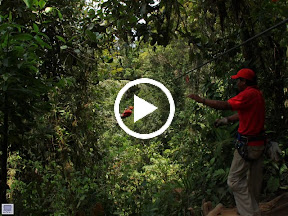Click above for all the photos.
The last place we visited in Ecuador was the town of Mindo, about a 2-hour drive north of Quito. We spent three nights at the
Mindo Gardens lodge, which itself was a 45-minute walk from the center of the very small town of Mindo. Mindo is a one-street town with loads of eco-lodges, but little in the way of food. What the area does have going for it is extensive bird activity and
zip-lines through the canopy of these high-altitude "cloud forests." Mindo is especially famous for one resident, the
Andean Cock-of-the-Rock. Each morning (in secret places only the $100-per-person guides know about) dozens of the male COTRs gather to court lady birds. Rarely do the ladies show up, but it's supposed to be quite the spectacle. However, due to a lack of sufficient funding, we didn't get to see real live Cock-of-the-Rock. We did see lots of other great animals, though, which you can see by clicking through the album.
We also engaged in Mindo's other two activities: visiting the butterflies
... and hurtling through the canopy on what I'm sure are very safe metal cables


